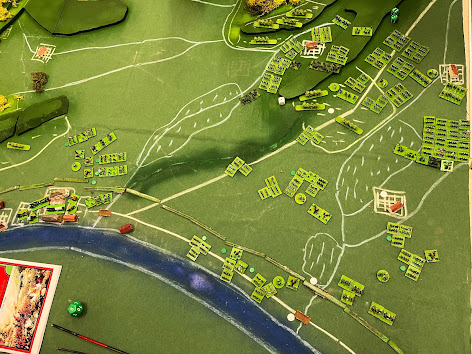After last week's excursion among the sun-kissed vineyards of northern Hungary, this week we were transported to the sun-baked sands of northern Egypt. As part of the "Bloody Big AFRICAN Battles!" project, we playtested Mark's scenario for Tel-el-Kebir (1882), the major action during the British conquest of Egypt.
Tel-el-Kebir on its own is not very exciting as a situation to wargame: a frontal assault on a simple line of entrenchments that was over in an hour after a rather one-sided fight. (See my post here on whether frontally assaulting redoubts can make a good game.) Mark's creative solution was to combine it with the preceding action at Kassassin. This entailed some compression of both time and space: Kassassin should really be another four feet away from the entrenchments, rather than on the table edge; and the 'Night Interval' between the two actions is actually the fortnight between 28 August and 13 September 1882. This compression did not create any distortion or other problem and produced a scenario in which both sides get to do some maneuvering and have some genuine decisions to make.
Herewith a brief photo-AAR followed by some reflections:
I only took photos of the first third of the game, so apologies that you will have to make do with my 1,000 words to paint a picture of the rest of it. Having repulsed the Egyptians from Kassassin, I needed to take 5 of the 9 remaining objectives to win. Two of these were villages among the palm groves and farms south of the canal (top left in first pic), the other seven being redoubts dotted among the entrenchments (all marked by white counters in first pic). In the Night Interval, my troops set up in the historical deployment for the assault on Tel-el-Kebir: Indian brigade on my left south of the canal; Highland Bde and 4th Bde north of it; a grand battery in the centre; 2nd Bde and Guards Bde on the right; Cavalry Division on the right flank.
Honestly, I found the prospect of assaulting the Egyptian fortifications daunting. Most of the Egyptian troops had modern breechloading rifles, with long effective range and deadly short range; they also had a lot of Krupp breechloading cannon, which are no fun to assault frontally. I was especially concerned about the risk to my cavalry (the BBB rules make them a more vulnerable target than infantry) so I fannied about trying to hide them initially, rather than using them to outflank or assault.
Still, I got stuck in eventually. On the left, the Indians took one objective village but ran out of time to reach the second. Next along, the Highlanders and 4th Bde took a long time to storm one objective redoubt, so although they then had another at their mercy, they only had one turn left to take it and failed the movement roll to do so. On my right, the Guards and the Household Cavalry broke in and took one redoubt; the HC were so successful they had a compulsory exploit that actually put them in a position where they had a chance at taking another redoubt in the second line of entrenchments, but didn't quite manage it; redoubts to right and left of the Guards' incursion were at risk on the last turn, but all my three units in range failed to get the necessary movement rolls.
Thus, I took 3 objectives, and had chances at 5 others on the last turn. As none of these came off, I was left with a defeat, but it was by no means a crushing one-sided one, as victory had been very much a possibility until those last few dice. It was a thoroughly entertaining game and should go down well when Mark takes it to the club.
Reflections:
Too much artillery. The typical BBB figure ratios are either 1,000 men / 24 guns per base or 1,500 men / 36 guns per base. For this scenario, Mark had used 500 men / 6 guns per base. That meant artillery was 100% overrepresented - no wonder I was daunted! It evened out to some extent, of course, because the British have plenty of artillery too, but it advantaged the Egyptians more because their guns were in fortifications and we had to approach in short range of them. Fixing the gun ratio shouldn't change the game balance radically but should make it a shade easier for the British to storm the redoubts they need to take.
Characterful units: it's always fun to be able to point out the Highlanders or the Guards. On the British side, Indian troops and the railway gun added further colour. On the Egyptian side, at one end of the scale were the Sudanese veterans - hardcore! - and at the other, a rabble of fellahin conscripts and Bedouin bashi-bazouks.
Scenario design: the concept of combining Kassassin and Tel-el-Kebir in a single game absolutely worked and made it far more interesting than the simple assault would have been. Punctuating games with a Night Interval always seems to have that effect, providing a significant pivot point that entails significant decisions before and during it and gives different aspects to the game.
Cavalry: nope, still don't really know how to use 'em. Any advice? Maybe we should dispense with the wretched nags and replace them with some kind of armoured landship powered by the new-fangled engines those German fellows invented in the 1870s.














